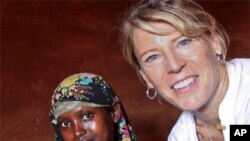The head of the humanitarian organization Save the Children has toured the Dadaab refugee camp in northeastern Kenya, calling the crisis in the Horn of Africa “quite staggering.”
Over 400,000 refugees, mostly Somalis, are at the Dadaab complex, with more than one thousand new arrivals each day.
“About half of those 1,000 or 1200 a day are children – really just streaming into these camps, needing assistance after some very, very tough journeys to get there,” said President and CEO Carolyn Miles.
There have been numerous reports of mothers being forced to leave children by the roadside because they were too weak to continue the 15 to 20 day walk to Dadaab.
For those children who reach the camps, she said, “Certainly, the children are not in great shape. About half of them are malnourished…. Now there is help along the way to make sure the kids are reaching the camps. So that’s the good news.”
Food, water and more
Besides meeting the immediate needs of food and water, Miles said another need is help for psychological trauma among children. “Some of them have been put with relatives. They don’t know where their parents are in some cases. They’ve been separated from their families, so there is a lot of trauma there as well.”
Save the Children has programs operating to help deal with it.
“We have staff right at the receiving centers and so when kids are coming in if they’re identified as not with their families – they’re with neighbors or other groups that they just join in with – we are working to try to trace their parents. And we are placing them inside the camps with foster families, which is a process to try to get them some stability in their lives,” she said.
Ethiopia
Climate and weather experts predict recurring droughts in the Horn of Africa. Miles said much of Save the Children’s work attempts to reduce the risk of disaster, such as improving food security.
“In fact," she said, “we believe that a lot of the work we’ve been doing in Ethiopia prevented another five or six million people from being at risk in this emergency. You don’t see that because it’s what didn’t happen. But these programs on food security are incredibly important.”
The aid group targeted its programs toward pastoralists.
“They go from place to place with their animals and we’re working with them on trying to make sure that they have good information about where there’s food for their animals – how they should be looking at adding to their ability to keep their families alive by also doing planting and doing some farming,” she said.
It may be more difficult to have such programs in Somalia due to the lack of security.
“It’s a very challenging place to work,” said Miles, “Right now the focus is on the short term humanitarian needs in Somalia and we are doing that…. There are people in these communities that obviously want to survive and they want their families to survive. And so a lot of our work is focused on working inside communities.”














